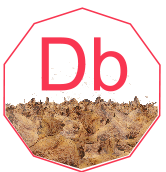Dubnium

Dubnium (Db)
General Information
- Symbol: Db
- Atomic Number: 105
- Atomic Weight: [268] u (most stable isotope)
- Element Category: Transition metal
- Group: 5
- Period: 7
- Block: d-block
Physical Properties
- Appearance: Unknown; predicted to be metallic and silvery
- Density: Estimated around 29 g/cm³
- Melting Point: Unknown; estimated around 1900-2100 K
- Boiling Point: Unknown
- Phase at STP: Solid (predicted)
- Electron Configuration: [Rn] 5f¹⁴ 6d³ 7s²
- Oxidation States: +5 (most common), +3 (less common)
Chemical Properties
- Reactivity: Dubnium is expected to exhibit chemical properties similar to those of tantalum and niobium. It forms stable +5 oxidation state compounds.
- Compounds: Predicted to form compounds such as dubnium(V) chloride (DbCl₅) and dubnium(V) oxide (Db₂O₅).
Uses and Applications
- Scientific Research: Primarily used in scientific research to study the properties of superheavy elements. Due to its short half-life and radioactivity, dubnium has no commercial applications.
Occurrence and Extraction
- Natural Occurrence: Dubnium does not occur naturally. It is a synthetic element.
- Extraction: Produced artificially in particle accelerators by bombarding lighter elements, such as californium or berkelium, with heavy ions like nitrogen or oxygen.
Isotopes
- Stable Isotopes: Dubnium has no stable isotopes.
- Radioactive Isotopes: Several radioactive isotopes, including Dubnium-268 with a half-life of about 32 hours, Dubnium-270 with a half-life of about 22 hours, and Dubnium-262 with a half-life of about 34 seconds.
Safety and Handling
- Hazards: Dubnium is highly radioactive and poses significant health risks due to its intense radioactivity. It requires specialized handling.
- Precautions: Handle with extreme caution using specialized protective equipment and facilities designed to contain radioactivity. Dubnium is typically handled in very small amounts under controlled conditions in research laboratories.
History
- Discovery: Discovered independently by a team at the Joint Institute for Nuclear Research in Dubna, Russia, in 1968, and by a team at Lawrence Berkeley National Laboratory in California, USA, in 1970.
- Name Origin: Named after the town of Dubna, Russia, where it was first synthesized.
Additional Facts
- Crystal Structure: Unknown
- Magnetic Properties: Unknown
- Thermal Conductivity: Unknown
- Electrical Resistivity: Unknown
Summary
Dubnium is a synthetic, highly radioactive transition metal with no commercial applications. It is primarily used in scientific research to study the properties of superheavy elements. Discovered in the late 1960s, it is named after the town of Dubna in Russia. Dubnium does not occur naturally and is produced in particle accelerators by bombarding lighter elements with heavy ions. Due to its radioactivity and short half-life, it requires specialized handling and is studied in controlled laboratory environments.
40 Question and Answer Pairs About Dubnium
What is the atomic number of Dubnium?
- 105
What is the symbol for Dubnium?
- Db
What is the atomic weight of Dubnium?
- [268] u (most stable isotope)
In which group of the periodic table is Dubnium found?
- Group 5
What period is Dubnium in?
- Period 7
What block does Dubnium belong to?
- d-block
What is the estimated melting point of Dubnium?
- Around 1900-2100 K
What is the estimated boiling point of Dubnium?
- Unknown
What is the estimated density of Dubnium?
- Around 29 g/cm³
What is the electron configuration of Dubnium?
- [Rn] 5f¹⁴ 6d³ 7s²
What are the common oxidation states of Dubnium?
- +5 (most common), +3 (less common)
What is the appearance of Dubnium?
- Unknown; predicted to be metallic and silvery
Is Dubnium reactive with air?
- Predicted to be similar to tantalum and niobium, forming stable +5 oxidation state compounds.
Name a predicted compound of Dubnium.
- Dubnium(V) chloride (DbCl₅)
What is a common use of Dubnium in scientific research?
- To study the properties of superheavy elements.
How is Dubnium used in particle accelerators?
- Produced by bombarding lighter elements with heavy ions.
What role does Dubnium play in commercial applications?
- It has no commercial applications due to its short half-life and radioactivity.
How is Dubnium found in nature?
- It does not occur naturally; it is a synthetic element.
How is Dubnium typically produced?
- By bombarding lighter elements with heavy ions in particle accelerators.
What is the most stable isotope of Dubnium?
- Dubnium-268
What is the half-life of Dubnium-268?
- About 32 hours
What safety hazard is associated with Dubnium?
- It is highly radioactive and poses significant health risks.
Who discovered Dubnium?
- Discovered independently by a team at the Joint Institute for Nuclear Research in Russia and a team at Lawrence Berkeley National Laboratory in the USA.
Where does the name Dubnium come from?
- Named after the town of Dubna, Russia.
What is the crystal structure of Dubnium?
- Unknown
Is Dubnium paramagnetic or diamagnetic?
- Unknown
What is the thermal conductivity of Dubnium?
- Unknown
What is the electrical resistivity of Dubnium?
- Unknown
What is the primary oxidation state of Dubnium?
- +5
Is Dubnium found as a free element in nature?
- No, it is a synthetic element.
What is the common name of Dubnium(V) oxide?
- Db₂O₅
What is a major application of Dubnium in scientific research?
- To study the properties of superheavy elements.
How does Dubnium benefit spectroscopic studies?
- Its heavy atomic weight helps in studying atomic interactions and properties.
What is the boiling point of Dubnium in Kelvin?
- Unknown
What group does Dubnium belong to in the periodic table?
- Transition metals (Group 5)
What is the natural abundance of Dubnium-268?
- It is a synthetic isotope with no natural abundance.
Can Dubnium be used in high-temperature applications?
- No, due to its radioactivity and short half-life.
What is the key property that makes Dubnium valuable in scientific research?
- Its position as a superheavy element.
How is Dubnium used in radiation research?
- As a source of alpha particles in experiments.
What precautions should be taken when handling Dubnium?
- Use specialized protective equipment and facilities to contain radioactivity.






